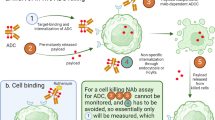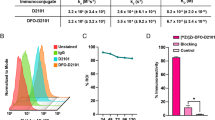Abstract
Affibody molecules are a class of small (ca.7 kDa) robust scaffold proteins with high potential as tracers for radionuclide molecular imaging in vivo. Incorporation of a cysteine-containing peptide-based chelator at the C terminus provides an opportunity for stable labelling with the radionuclide 99mTc. The use of a GGGC chelator at the C terminus has provided the lowest renal radioactivity retention of the previously investigated peptide-based chelators. Previously, it has also been demonstrated that replacement of the His6-tag with the negatively charged histidine-glutamate-histidine-glutamate-histidine-glutamate (HEHEHE)-tag permits purification of affibody molecules by immobilized metal ion affinity chromatography (IMAC) and provides low hepatic accumulation of radioactivity of conjugates site-specifically labelled at the C terminus using several different nuclides. We hypothesized that the combination of a HEHEHE-tag at the N terminus and a GGGC chelator at the C terminus of an affibody molecule would be a favourable format permitting IMAC purification and providing low uptake in excretory organs. To investigate this hypothesis, a (HE)3-ZHER2:342-GGGC affibody molecule was generated. It could be efficiently purified by IMAC and stably labelled with 99mTc. 99mTc-(HE)3-ZHER2:342-GGGC preserved specific binding to HER2-expressing cells. In NMRI mice, hepatic uptake of 99mTc-(HE)3-ZHER2:342-GGGC was lower than the uptake of the control affibody molecules, 99mTc-ZHER2:2395-VDC and 99mTc-ZHER2:342-GGGC. At 1 and 4 h after injection, the renal uptake of 99mTc-(HE)3-ZHER2:342-GGGC was 2–3-fold lower than uptake of 99mTc-ZHER2:2395-VDC, but it was substantially higher than uptake of 99mTc-ZHER2:342-GGGC. Further investigation indicated that a fraction of 99mTc was chelated by the HEHEHE-tag which caused a higher accumulation of radioactivity in the kidneys. Thus, a combination of a HEHEHE-tag and the GGGC chelator in targeting scaffold proteins was found to be undesirable in the case of 99mTc labelling due to a partial loss of site-specificity of nuclide chelation.









Similar content being viewed by others
References
Carlsson J, Nordgren H, Sjöström J, Wester K, Villman K, Bengtsson NO, et al. HER2 expression in breast cancer primary tumours and corresponding metastases. Original data and literature review. Br J Cancer. 2009;90:2344–8.
Meden H, Kuhn W. Overexpression of the oncogene c-erbB-2 (HER2/neu) in ovarian cancer: a new prognostic factor. Eur J Obstet Gynecol Reprod Biol. 1997;71:173–9.
Wester K, Sjöström A, de la Torre M, Carlsson J, Malmström PU. HER-2—a possible target for therapy of metastatic urinary bladder carcinoma. Acta Oncologica. 2002;41:282–8.
Yarden Y, Sliwkowski MX. Untangling the ErbB signalling network. Nat Rev Mol Cell Biol. 2001;2:127–37.
Callahan R, Hurvitz S. Human epidermal growth factor receptor-2-positive breast cancer: current management of early, advanced, and recurrent disease. Curr Opin Obstet Gynecol. 2011;23:37–43.
Lordick F. Trastuzumab: a new treatment option for HER2-positive metastatic gastric and gastroesophageal junction cancer. Future Oncol. 2011;7:187–99.
Wolff AC, Hammond ME, Schwartz JN, et al. American Society of Clinical Oncology/College of American Pathologists guideline recommendations for human epidermal growth factor receptor 2 testing in breast cancer. J Clin Oncol. 2007;25:118–45.
Tolmachev V, Stone-Elander S, Orlova A. Radiolabelled receptor-tyrosine-kinase targeting drugs for patient stratification and monitoring of therapy response: prospects and pitfalls. Lancet Oncol. 2010;11:992–1000.
Löfblom J, Feldwisch J, Tolmachev V, Carlsson J, Ståhl S, Frejd FY. Affibody molecules: engineered proteins for therapeutic, diagnostic and biotechnological applications. FEBS Lett. 2010;584:2670–80.
Ahlgren S, Tolmachev V. Radionuclide molecular imaging using affibody molecules. Curr Pharm Biotechnol. 2010;11:581–9.
Orlova A, Magnusson M, Eriksson TL, Nilsson M, Larsson B, Höidén-Guthenberg I, et al. Tumor imaging using a picomolar affinity HER2 binding affibody molecule. Cancer Res. 2006;66:4339–48.
Tolmachev V. Imaging of HER-2 overexpression in tumors for guiding therapy. Curr Pharm Des. 2008;14:2999–3019.
Orlova A, Nilsson FY, Wikman M, Widström C, Ståhl S, Carlsson J, et al. Comparative in vivo evaluation of technetium and iodine labels on an anti-HER2 affibody for single-photon imaging of HER2 expression in tumors. J Nucl Med. 2006;47:512–9.
Ahlgren S, Wållberg H, Tran TA, et al. Targeting of HER2-expressing tumors with a site-specifically 99mTc-labeled recombinant affibody molecule, ZHER2:2395, with C-terminally engineered cysteine. J Nucl Med. 2009;50:781–9.
Ahlgren S, Orlova A, Rosik D, et al. Evaluation of maleimide derivative of DOTA for site-specific labeling of recombinant affibody molecules. Bioconjug Chem. 2008;19:235–43.
Hofstrom C, Orlova A, Altai M, Wangsell F, Graslund T, Tolmachev V. Use of a HEHEHE purification tag instead of a hexahistidine tag improves biodistribution of affibody molecules site-specifically labeled with (99m)Tc, (111)In, and (125)I. J Med Chem. 2011;54:3817–26.
Engfeldt T, Orlova A, Tran T, et al. Imaging of HER2-expressing tumours using a synthetic affibody molecule containing the 99mTc-chelating mercaptoacetyl-glycyl-glycyl-glycyl (MAG3) sequence. Eur J Nucl Med Molecular Imaging. 2007;34:722–33.
Engfeldt T, Tran T, Orlova A, et al. 99mTc-chelator engineering to improve tumour targeting properties of a HER2-specific affibody molecule. Eur J Nucl Med Molecular Imaging. 2007;34:1843–53.
Tran T, Engfeldt T, Orlova A, et al. 99mTc-maEEE-ZHER2:342, an affibody molecule-based tracer for detection of HER2-expression in malignant tumors. Bioconjug Chem. 2007;18:1956–64.
Ekblad T, Tran T, Orlova A, et al. Development and preclinical characterisation of 99mTc-labelled affibody molecules with reduced renal uptake. Eur J Nucl Med Mol Imaging. 2008;35:2245–55.
Tran T, Ekblad T, Orlova A, et al. Effects of lysine-containing mercaptoacetyl-based chelators on the biodistribution of 99mTc-labeled anti-HER2. Bioconjug Chem. 2008;19:2568–76.
Orlova A, Tran TA, Ekblad T, Karlström AE, Tolmachev V. (186)Re-maSGS-Z (HER2:342), a potential affibody conjugate for systemic therapy of HER2-expressing tumours. Eur J Nucl Med Mol Imaging. 2010;37:260–9.
Wållberg H, Orlova A. Slow internalization of anti-HER2 synthetic affibody monomer 111In-DOTA-ZHER2:342-pep2: implications for development of labeled tracers. Cancer Biother Radiopharm. 2008;23:435–42.
Ahlgren S, Andersson K, Tolmachev V. Kit formulation for 99mTc-labeling of recombinant anti-HER2 affibody molecules with a C-terminally engineered cysteine. Nucl Med Biol. 2010;37:539–49.
Wållberg H, Orlova A, Altai M, Hosseinimehr SJ, Widström C, Malmberg J, et al. Molecular design and optimization of 99mTc-labeled recombinant affibody molecules improves their biodistribution and imaging properties. J Nucl Med. 2011;52:461–9.
Altai M, Wållberg H, Orlova A, Rosestedt M, Hosseinimehr SJ, Tolmachev V, et al. Order of amino acids in C-terminal cysteine-containing peptide-based chelators influences cellular processing and biodistribution of (99m)Tc-labeled recombinant affibody molecules. Amino Acids. 2011. doi:10.1007/s00726-011-0927-x.
Wållberg H, Löfdahl PK, Tschapalda K, Uhlén M, Tolmachev V, Nygren PK, et al. Affinity recovery of eight HER2-binding affibody variants using an anti-idiotypic affibody molecule as capture ligand. Protein Expr Purif. 2011;76:127–35.
Tolmachev V, Hofström C, Malmberg J, Ahlgren S, Hosseinimehr SJ, Sandström M, et al. HEHEHE-tagged affibody molecule may be purified by IMAC, is conveniently labeled with [99(m)Tc(CO)3](+), and shows improved biodistribution with reduced hepatic radioactivity accumulation. Bioconjug Chem. 2010;21:2013–22.
Lundberg E, Brismar H, Gräslund T. Selection and characterization of affibody ligands to the transcription factor c-Jun. Biotechnol Appl Biochem. 2009;52:17–27.
Persson M, Tolmachev V, Andersson K, Gedda L, Sandström M, Carlsson J. [(177)Lu]pertuzumab: experimental studies on targeting of HER-2 positive tumour cells. Eur J Nucl Med Mol Imaging. 2005;32(12):1457–62.
Tran TA, Rosik D, Abrahmsén L, Sandström M, Sjöberg A, Wållberg H, et al. Design, synthesis and biological evaluation of a multifunctional HER2-specific affibody molecule for molecular imaging. Eur J Nucl Med Mol Imaging. 2009;36:1864–73.
Acknowledgements
This research was financially supported by grants from Swedish Cancer Society (Cancerfonden) and Swedish Research Council (Vetenskapsrådet).
Conflicts of interest
None.
Author information
Authors and Affiliations
Corresponding author
Additional information
Hanna Lindberg and Camilla Hofström contributed equally to this study.
Rights and permissions
About this article
Cite this article
Lindberg, H., Hofström, C., Altai, M. et al. Evaluation of a HER2-targeting affibody molecule combining an N-terminal HEHEHE-tag with a GGGC chelator for 99mTc-labelling at the C terminus. Tumor Biol. 33, 641–651 (2012). https://doi.org/10.1007/s13277-011-0305-z
Received:
Accepted:
Published:
Issue Date:
DOI: https://doi.org/10.1007/s13277-011-0305-z




